Bond LSC Research
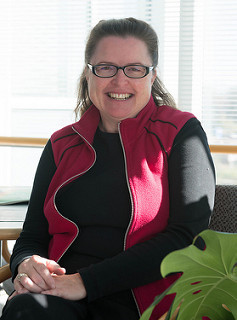
June 7, 2017
The evolution of a corn geneticist
By Jennifer Lu |Bond LSC Paula McSteen is a professor of biological sciences at MU and a researcher at the Bond Life Sciences Center. | Photograph by Jennifer Lu, Bond LSC When developmental plant geneticist Paula McSteen thinks about the specimens she studies, one word comes to mind: potential. She thought it as she stood in the midst of the first corn field she ever planted as a post-doctoral fellow in corn genetics. She thinks it as she counts kernels from corn crosses that will be sent to Hawaii, a hotspot for corn geneticists looking to…
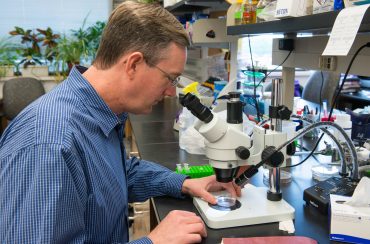
May 24, 2017
Small steps to treat neuromuscular disorder
Researchers find evidence of a genetic modifier that can improve symptoms of Spinal Muscular Atrophy Chris Lorson examines axons through a microscope. Lorson’s lab recently published results that showed evidence that the protein plastin 3 affects the severity of SMA. | Photo by Eleanor Hasenbeck, Bond LSC Eleanor Hasenbeck | Bond Life Sciences Center Two new potential treatments might improve the lives of patients living with Spinal Muscular Atrophy. Researchers in the Lorson lab at Bond Life Sciences Center recently produced a new drug that increases the lifespans of mice with SMA, and they found…
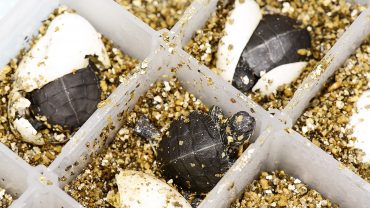
May 15, 2017
BPA rewires the sex of turtle brains
By Jinghong Chen | Bond Life Sciences Center Painted turtle eggs were brought from a hatchery in Louisiana, candled to ensure embryo viability and then incubated at male-permissive temperatures in a bed of vermiculite. Those exposed to BPA developed deformities to testes that held female characteristics.Photo by Roger Meissen | © 2015 – MU Bond Life Sciences Center Cool dudes, hot mommas. This is the underlying concept behind sex development in painted turtles, a species that lacks sex chromosomes. A painted turtle’s sex is determined by temperature at which the eggs are incubated at…
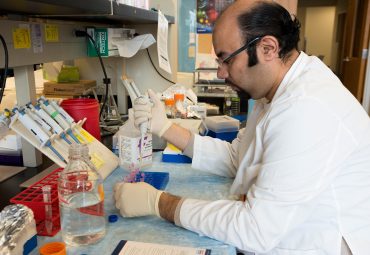
March 23, 2017
Why self-defense turns self-attack
By Jinghong Chen | Bond Life Sciences Center Mahmoud Khalafalla, a Ph.D. student at Weisman’s lab, is isolating RNA from salivary glands of Sjögren’s syndrome mouse model to look for the expression of pro-inflammatory genes. | photo by Jinghong Chen, Bond LSC Our immune system is often the key to our health. Everyday, it works to protect us from foreign invaders such as bacteria and virus, but what happens when it attacks our own tissues? Gary Weisman, a Curator’s Distinguished Professor of Biochemistry at the Bond Life Sciences Center, is working to advance our understanding of…
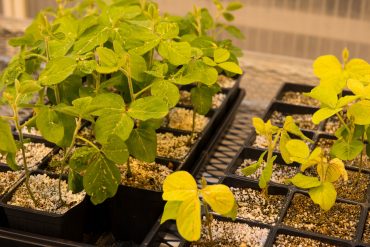
March 17, 2017
Planting a seed for sciences
Jinghong Chen | Bond Life Sciences Center Plants on the left grow with rhizobia bacteria, one type of fixing nitrogen bacteria, in the greenhouse, while the plants on the right grow without the bacteria. | photo by Jinghong Chen, Bond LSC Since eight years old, Beverly Agtuca knew she wanted to be a scientist. A trip to Philippines changed Agtuca, an American-born Filipino, and inspired her passion on plants. “My grandma always told me to work in the field all day so that they can have enough food for us to eat,” Agtuca said. “The life…
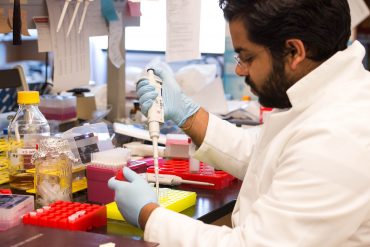
Feb. 17, 2017
Art of balance
Jinghong Chen | Bond Life Sciences Center Vinit Shanbhag mixes the CRISPR plasmid DNA with cells. The lab will test whether the gene of interest has been knocked out of the cells later. | photo by Jinghong Chen, Bond LSC It might be strange to say, but in a way the Australian soil led scientist Michael Petris to where he is now. In certain areas of Australia, soils suffer from extremely low level of copper bioavailability, resulting in poor growth and neurological problems on sheep. Petris, a Bond LSC investigator and professor of biochemistry who was…
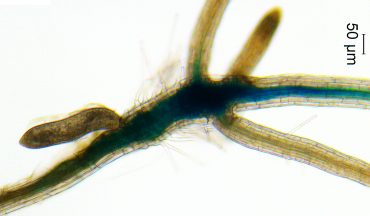
Feb. 10, 2017
Chemical persuasion
Scientists prove parasite mimics key plant peptide to feed off roots By Roger Meissen | Bond LSC A nematode (the oblong object on the left) activates the vascular stem cell pathway in the developing nematode feeding site (syncytium) on a plant root. | photo by Xiaoli Guo, MU post-doctoral research associate When it comes to nematodes, unraveling the root of the issue is complicated. These tiny parasites siphon off the nutrients from the roots of important crops like soybeans, and scientists keep uncovering more about how they accomplish this task. Research from the…
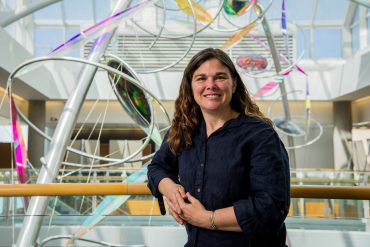
Jan. 11, 2017
Cornelison receives highest honor from White House
It feels good to get recognition, especially when it comes from the White House. This week D Cornelison, a Bond Life Sciences Center researcher and associate professor of biological sciences found out she will receive a Presidential Early Career Award for Scientists and Engineers (PECASE). The award is the highest honor bestowed by the United States government on science and engineering professionals in the early stages of their independent research careers. She joins 102 researchers this year selected by the White House to receive this prestigious award. This is a first for Missouri as a state…
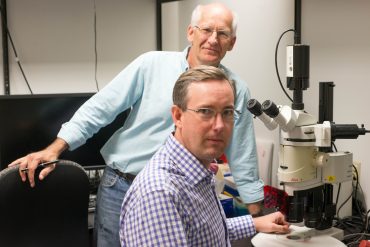
Nov. 17, 2016
Live long and prosper: healthy mitochondria, healthy motor neurons?
Chris Lorson (front) and Mark Hannink (back) collaborate to study the role of mitochondria in motor neuron health, particularly in relation to spinal muscular atrophy, a neuromuscular disorder | photo by Jen Lu, Bond LSC Chris Lorson, a professor of veterinary pathobiology, and Mark Hannink, a professor of biochemistry, want to find a new way to help motor neurons live a long and healthy life. Their question: what’s the relationship between motor neuron sruvival and a cellular component called mitochondria? The two researchers at the Bond Life Sciences Center were awarded preliminary funding from the Bond…

Nov. 4, 2016
The eyes have it
Bond LSC scientist works with MU eye surgeon to help people suffering from autoimmune-disease Sjögren’s syndrome By Phillip Sitter | Bond LSC Dr. Carisa Petris stands in the McQuinn atrium of Bond Life Science Center. She and Bond LSC researcher Gary Weisman are using funding from a $100,000 Bond LSC grant to study the mechanisms of an auto-immune disease in the lacrimal glands of the eyes. They are hoping treatments for the disease in mice they study could be applied to humans. | photo by Phillip Sitter, Bond LSC They may not get much…
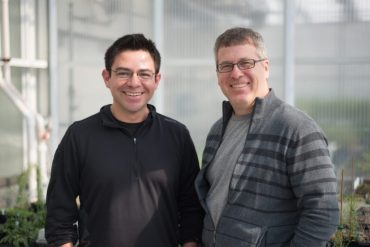
Oct. 25, 2016
Close encounters of the plant protein kind
Bond LSC researchers David Mendoza (left) and Scott Peck (right) are collaborating to develop a new method for studying protein signaling pathways inside plant cells. | photo by Jennifer Lu, Bond LSC By Jennifer Lu | Bond LSC Sometimes, timing is everything. That was the case in what led to a new collaboration between the Mendoza and Peck laboratories. The two researchers were recently awarded $48,250 in seed money from the Bond Life Sciences Center to adapt a new technology to the study of signaling pathways in plant cells. David Mendoza, a Bond LSC researcher and…
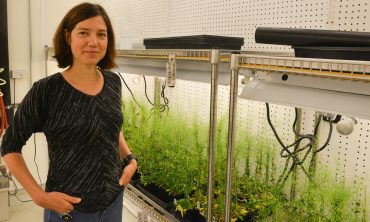
Oct. 11, 2016
The seeds of progress
Efforts to understand the genome of one plant through its many genetic varieties could lead to nutritional improvements in the staple crops billions of people depend on By Phillip Sitter | Bond LSC Ruthie Angelovici stands next to some Arabidopsis thaliana samples in the basement of Bond LSC. She is leading projects to study the relationships between genotypic and phenotypic variation in Arabidopsis and how this affects the amino acid content of the plants, and the resistance of their seeds to drought conditions. | Phillip Sitter, Bond LSC It’s hard to avoid corn, rice or soybeans…